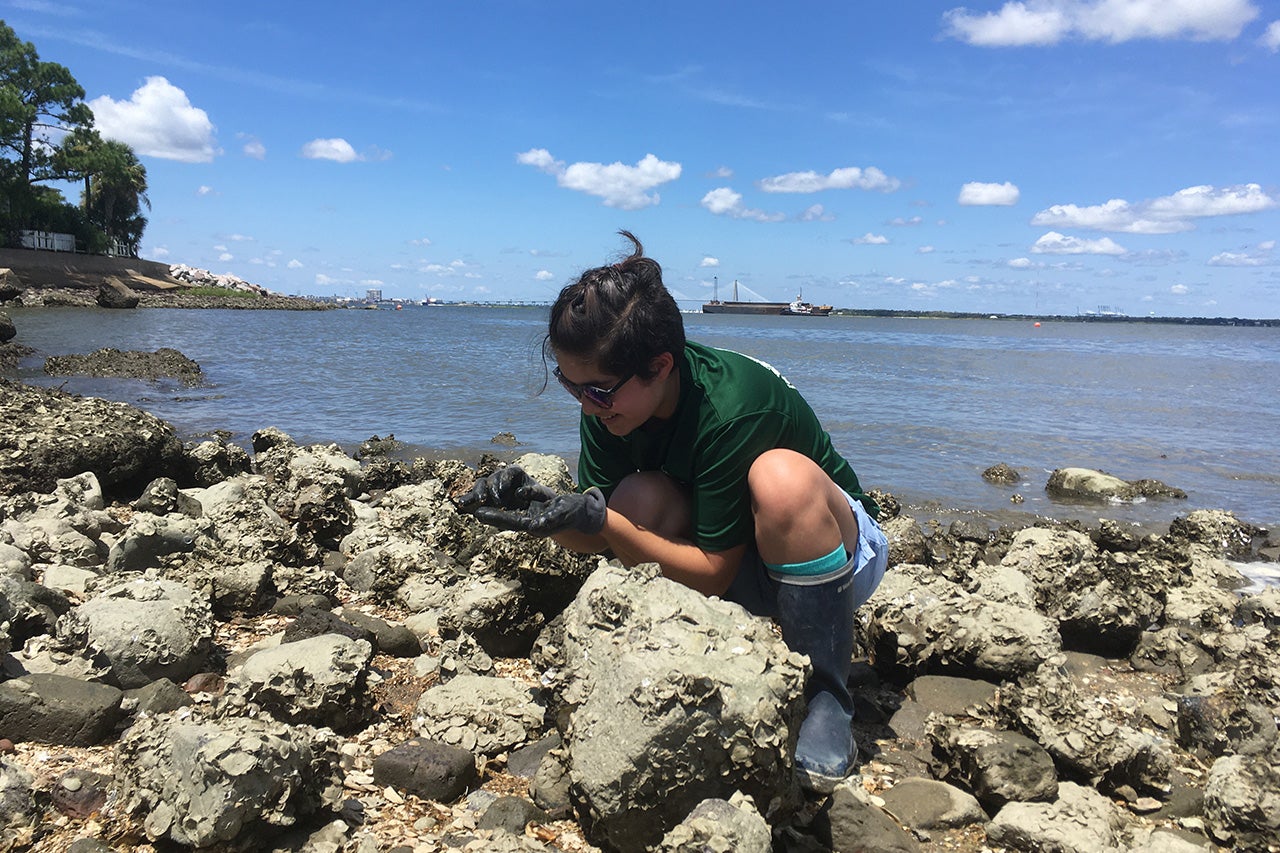It’s kind of fitting that, when Rowan Emerson, Morgan Lattomus and Hails Tanaka emerged from quarantine early last summer, it was to focus on research at the Grice Marine Laboratory at Fort Johnson. Turns out, leaving quarantine to focus on research is kind of a trend for Fort Johnson, which served as the Port of Charleston’s quarantine station for around 70 years before it became a hub for marine science research.
Now home to the Grice Marine Lab, the College of Charleston’s core facility in support of marine sciences, the property is typically buzzing with marine biology faculty members and undergraduate and graduate students conducting research – especially during the summer months, when the lab usually hosts 10 students from all over the country for the Fort Johnson Research Experiences for Undergraduates Program.
This year, of course, was different.
“It was definitely quieter this summer,” says Tanaka (pictured above), whose research focuses on the effects of parasitism by an invasive rhizocephalan parasite on the mechanical performance of mud crabs. “When I would come during the week last spring, there were just so many people – staff, grad students, professors – around that it didn’t feel quite as haunting as it did some days this summer when I was the only person in the building on a Tuesday morning.”
“Other than the work of these students, much of the work in the building had ground to a halt,” says Bob Podolsky, director of Grice Marine Lab. “Despite restrictions on the use of Grice Marine Lab this summer – doors were locked, we were short staffed, students needed special permission to work in the building, and strict enforcement of social distancing and wearing masks was in place – these students came each day and formed a little community.”
And that community has continued to flourish into the fall semester as these three students keep pushing their scientific investigations forward.
“Bob has taken the time to walk through ideas, procedures and random queries with me,” says Tanaka, who worked with Podolsky putting together methods, testing salinities of the crabs and analyzing the recent presence of the parasite in Charleston Harbor. “He’s been really supportive of me wanting to expand and branch off into different directions with my research.”
One direction that Tanaka is taking the research this semester is toward mobility experiments based on limb detachment.
“Basically, the parasitized crabs can’t molt, so if they lose a feeding claw, they can’t eat anymore. So, we are looking to see if the parasites are strengthening those limbs more so than in the unparasitized mud crabs,” says the junior marine biology major. “I think it is important to research, especially because the parasite is invasive to the area and has an effect on the local mud crab population. I think the crabs that we have here in Charleston are really important for the diversity of the estuary.”
Lattomus, whose research looks at the presence of microplastics in shark pups, is also interested in the life of local area estuaries.
“Understanding how anthropogenic pollution affects sharks in their earliest stages is important given Charleston estuaries are vital birthing grounds for at least five species of sharks,” says Lattomus, a junior marine biology major, who worked on the project with biology professor Gorka Sancho and plans to join associate professor of geology Barbara Beckingham to begin data analysis next. “I’ve always loved sharks, and microplastics are becoming a more prominent issue in marine environments.”
Yet another prominent issue in marine environments is the topic of Emerson’s research project, “Effects of the Eastern Mud Snail on Benthic Bacterial and Microalgal Community Structure.”
“The Eastern Mud Snail has become an invasive species in areas of the Pacific coast, and their impact isn’t completely understood, so hopefully this research will shed some light on their potential impact on other communities as they spread along the western coast,” says Emerson, a junior biology major who worked with biology professor Craig Plante on the project. “Dr. Plante was extremely supportive in helping to design and plan the experiment. He showed me the ropes with all of the equipment and techniques, as this was my first research opportunity.”
Indeed, all three students agree that – in addition to the support they received through School of Sciences and Mathematics Summer Research Grants – the support of their faculty mentors allowed their research to be successful.
“Working with Dr. Sancho has been really awesome this summer, as he’s been an amazing sounding board for all my ideas and was super supportive of me as I conducted my own research for the first time,” says Lattomus. “He was a huge advocate for me to go in the field with SCDNR, and continues to check in and support me.”
“I would say we have a really good working relationship where questions and exploration is always welcome,” says Tanaka of working with Podolsky. “I think he has really helped my project be more successful because we can discuss problems and new ideas easily.”
Podolsky, for his part, is proud of the students’ commitment to their research – especially considering the pandemic.
“It took real dedication and diligence to come to work, put on a mask and keep the research going,” he says. “Despite the circumstances, students need access to this experience.”
The way Tanaka sees it, students need access to this experience because of the circumstances.
“Especially during the pandemic, I found a lot of comfort in conducting research,” says Tanaka. “I was really heavily quarantining at home because I have high-risk family members, so moving here and working gave me a lot of structure and focus that had given way to general anxiety and unrest the previous months.”
Indeed, there’s a lot to be said for leaving quarantine behind and focusing on research – especially at Fort Johnson.





